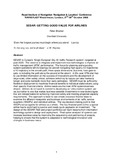- CERES Home
- →
- School of Engineering (SoE)
- →
- Staff publications (SoE)
- →
- View Item
JavaScript is disabled for your browser. Some features of this site may not work without it.
| dc.contributor.author | Brooker, Peter | |
| dc.date.accessioned | 2008-12-15T12:39:37Z | |
| dc.date.available | 2008-12-15T12:39:37Z | |
| dc.date.issued | 2008-10 | |
| dc.identifier.citation | Peter Brooker, SESAR: Getting Good Value for Airlines. Royal Institute of Navigation 'Navigation and Location' Conference. NAV08/ILA37, Westminster, London, 27-30th October 2008. | en_UK |
| dc.identifier.uri | http://hdl.handle.net/1826/3056 | |
| dc.description.abstract | SESAR is Europe’s ‘Single European Sky Air traffic Research system’, targeted at post 2020. The vision is to integrate and implement new technologies to improve air traffic management (ATM) performance. The focus for planning and executing system operations will increasingly be aircraft navigating high-quality 4D trajectories: a 4D trajectory is the aircraft path, three space dimensions plus time, from gate-to-gate, ie including the path along the ground at the airport. A 20+ year ATM plan has to use limited information on the success of innovations and the development of large-scale, often safety critical, software (which by its nature can take markedly longer and costs markedly more than early estimates). SESAR must be sufficiently flexible in deployment to maximise financial benefits to individual stakeholders using their specific financial criteria. Airline needs are the main ATM system/business drivers. Airlines do not want to commit to developing an ‘ultra-modern system’ per se, but rather to one that makes business-sensible investments in new technologies that are indispensable for achieving improved safety and meeting projected capacity requirements. The approach is been to use simple corporate finance ideas to examine the different viewpoints and business environments of air traffic service suppliers (‘ANSPs’) and individual airlines. The key decision-making point is that ANSPs act as agents for airlines as a whole. The key financial point is that a typical airline has to work hard to survive and needs quick paybacks on investment. The design of the SESAR R&D and project portfolios can learn lessons from information technology systems design and deployment. ‘Real option analysis’ of systems can increase business value by improving the sequencing and partitioning of projects, helping to ensure that the system is adaptable to technological innovation and changes in business needs. | en_UK |
| dc.language.iso | en | en_UK |
| dc.title | SESAR: Getting Good Value for Airlines. | en_UK |
| dc.type | Conference paper | en_UK |
Files in this item
This item appears in the following Collection(s)
-
Staff publications (SoE) [603]
